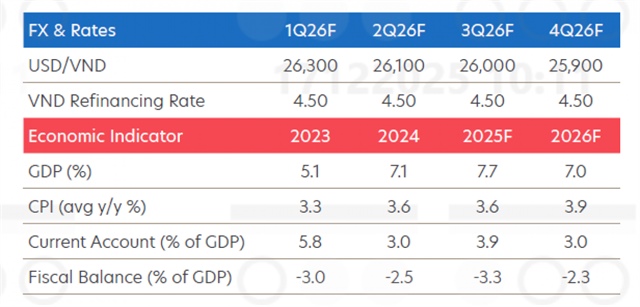Bad debt plagues financial sector
Bad debt plagues financial sector
While the State Bank of Vietnam (SBV) has claimed the country’s ratio of bad debts increased to 3.6% by the middle of April, other studies claim the figure could be three to four times higher.
A group of economists recently released the Vietnam Annual Economic report which said that the rate of bad debts among the country’s banks fluctuates from 8.25% to 14.01%.
The report was jointly conduced by Vietnam Centre for Economic and Policy Research (VEPR) under Vietnam National University – Hanoi’s University of Economics and Business; National Economics University; Vietnam Academy of Social Sciences and some other research institutes.
The report also included different estimates on the issue from several organisations.
According to StoxPlus, a Vietnamese financial portal, banking bad debts averaged at 2.3%. Meanwhile, Fitch Ratings claim Vietnam’s banking system is saddled with a bad debt rate of 13%.
The research group cited analyst Ho Ba Tinh who claimed that the bad debt rate could be from 7%-8%, and even over 10%, equivalent to around VND300 trillion (USD14.36 million).
The Vietnamese banking sector’s contingency funds currently don’t follow international norms, while bad debts among state-owned enterprises account for 70% of banks’ total bad debts.
During 2011 and the first quarter of 2012, businesses faced numerous difficulties, forcing thousands of enterprises to close. The situation was worsened by the decline in the real estate and securities market, adding to banking bad debts.
Dr. Quach Manh Hao said the research group had reached their conclusion about banking bad debt rate mainly based on securities and real estate-based lending. Outstanding loans for these industries accounted for 10%-12% of the banking system’s total lending.
“If the SBV’s figure is accurate that the banking bad debt rate increased from 3.2% in early 2012 to 3.6% by the middle of April, all securities and real estate-based loans could be classified as bad debts,” Hao noted.
The research group conducted the report by studying the bad debts held by 41 banks in Vietnam. Their calculation did not include Vinashin’s debts.
Solutions needed
Even though there has been no final conclusion on the rate of bad debts, the SBV’s figure means a considerable increase in bad debts among banks. This is a result of the currently gloomy economic outlook.
Many big banks have been troubled by several major clients failing to repay their debts.
Financial reports have showed that bad debts are on the rise among listed banks. Vietcombank reported an increase in its bad debts from 2.03% to 2.87% by the end of March. Its unrecoverable debts rose to 32%, worth VND3.1 trillion (USD148.53 million).
Vietinbank’s bad debts also increased from 0.75% in early 2012 to 1.85% by the end of the first quarter.
Eximbank’s bad debts increased from 1.6% to nearly 2% while ACB’s figure was up from 0.85% in late 2011 to over 1% by the end of March.
After the merger with Sacombank or SHB, Habubank’s leaders announced a bad debt rate at 16.06% by the end of February. The figure changed to 9.7% by the end of March, according to its financial report for the first quarter of this year.
Several experts said that bad debts were an inevitable in current circumstances. However, they emphasised the necessity to find a solution.
On March 1, the Prime Minister issued Decision No. 254 on restructuring financial institutions for the 2011-2015 period, which is considered the main method of dealing with incompetent banks.
The decision allows the SBV to buy stakes in weak banks and grant foreign institutions the right to increase their stake in domestic banks. It also encourages big banks to buy assets and debts from incompetent banks while allowing banks to sell their debts to a Debt and Asset Trading Company (DATC).
On May 15, the SBV issued a regulation that allowed the 14 biggest commercial banks to trade in debts.
This is expected to help minimise the costs of banking restructuring.
dtinews






















